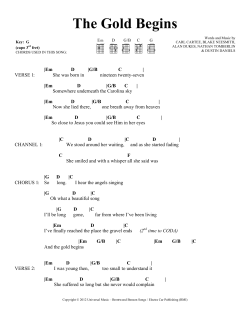
How to Maintain the Rural Road by Ourselves Makoto KIMURA
11/12/2012 JUBA, SOUTH SUDAN How to Maintain the Rural Road by Ourselves Makoto KIMURA Professor, Department of Civil and Earth Resources Engineering, Kyoto University, JAPAN Chairperson of Board, Community Road Empowerment (NGO) kimura.makoto.8r@kyoto-u.ac.jp How do we repair rural roads without any machine ? What can I do for rural people as a geotechnical engineer. Challenges and Good Solutions September, 2007 Vehicle per day < 50 Practical construction in East Uganda May, 2008 201 (Times)-60(Africa)-36(Kenya)-14(Expert)-64(Countries)-0.300 Problems in rural area (Cause of the poverty) Farm River Rural road (Unpaved) Cash Crops Well Main Road (Paved) Market Agricultural Community Can’t Transport Agricultural Product during Rainy Season Crops are spoiled Can’t get money 4 Always waiting heavy machine !! How to empower rural communities? 5 Which technology can solve the problem? (Four L) 40 cm Do-nou: GEOTEXTILE (Japanese term of soilbag) 40 cm Prevent floodwaters from going over dikes 1. 2. 3. 4. Building firm SUBBASE Locally available material Labour based Low cost Low technology 6 “MICHIBUSHIN” 55 years ago in Japan Communities’ voice Above those were the answers from the group members, “What is a road for you?” Above those were the answers from the group members, “What is “Do-nou” technology for you?” Due to the financial deficit, roads are not maintained. 9 Japanese road condition about 50 years ago “Do-nou” technology!! Characteristics of “Do-nou” 40 x 40 x 10 cm, 20 kg Material Low cost material Plastic (polypropylene) “Do-nou” bag Bags for sugar/maize Material put inside the bag Construction Soil near the site Labor based Simple No curing period Wooden mallet Compressive pressure Bearing Capacity (250 kN) 12 How to Generate the Strength of the ”Do-nou”? Bag External force Soil Soil is wrapped with bag Tensile strength External force applied to “do-nou” Tensile strength is generated. The soil inside the bag is reinforced. Mechanism is simple. Do-nou is the ultimate geotextile. Careful work (compaction) is necessary. Standard cross sections of road maintained using “Do-nou” technology 0.8 m The surface whose base coarse is not reinforced settle. 0.8 m 0.2 m Top layer Thickness: 0.05 m The surface whose base coarse is reinforced with Do-nou is firm. 14 Application of the“Do-nou” Construction of a retaining wall with 30,000 do-nou Application of the“Do-nou” Do-nou 捨てコンクリト 約600 400 連結スル 連結土のう 連結土のう 連結土のう 連結土のう 縫イツケル Tying the openings 1600~1800 軟弱地盤 Soft clay N値=1~2 N value = 1~2(単位:mm) Unit:mm Field construction by do-nou to reinforce soft building foundation Mechanism where the Strength of “Do-nou” is Generated. σ1f ・Tension T produces an additional stress H Tension of bag, T T Soilbag Do-nou 01 2T B 03 2T H σ3f T ・The shear destruction is done under the stresses acting as shown in Fig.2 Tension of bag, T B 1 f 01 K p 3 f 03 Fig. 1 Stresses acting on Do-nou σ1f Kp : coefficient of Passive earth pressure KP σ01=2T/B H σ3f Soilbag Do-nou B σ03=2T/H Fig. 2 Stresses acting on particles inside Do-nou Reference: Matsuoka, H. and Liu, S. : A New Earth Reinforcement Method using Soilbags, London, Taylor & Francis Group, 2006. 1 sin 5.55 1 sin Internal friction angle of materials inside the Do-nou 1 f 2T 2T K p 3 f B H 1f 3 f K p 2T B K P 1 B H The Load F of the “Do-nou” at Failure The load F of the Do-nou at failure 2T B F K P 1 BL B H T (1) : Tensile Strength of Do-nou 1 sin KP 5.55 1 sin Internal friction angle of materials inside the Do-nou = 44 ° B, L, H shows the size of Do-nou H=10 Do-nou made from polypropylene ( cm ) T = 6.0 kN/m (1) Reference: Matsuoka, H. and Liu, S. : A New Earth Reinforcement Method using Soilbags, London, Taylor & Francis Group, 2006. F 102kN(10.2tf ) Specification of Do-nou bags Unit Polypropylene Woven bag Material Polypropylene Size cm 60 x 45 Weight g /bag 42 ~ 45 Weight of 500 bags (1 roll) Kg/500 bag 21 ~ 23 2T B K 1 BL P B H Number of strings in per inch /inch 9-10 : Tensile Strength of Do-nou Tensile strength kN/m 6.0 The load F of the Do-nou at failure F T Name KP 1 sin 1 sin B, L, H shows the size of Do-nou Weight and number of strings in per inch are indicators To see whether the bags own enough tensile strength, which is 6.0 kN /m. MATERIAL PUT INSIDE THE BAGS TOP LAYER : GRAVEL WITH OPTIMUM MOISTURE CONTENT INSIDE DO-NOU: IN-SITU SOIL DIPOSAL SOIL GRAVEL SOIL SOIL TYPE Single Grained Gravel Wide range grained gravel Sand 30 20 10 0 0 10 20 Strain (%) (Settlement) 30 20 With villager at 13 countries 21 Voice of the people who experienced road maintenance using Do-nou • Now I am confident I can maintain the road. Initially I was not very sure I could. • I am very happy because the road has brought about good positive changes to our community. • Initially I felt it was a difficult job needing a lot of energy but in the end I realized it was easy. • In the beginning we did not have idea about maintaining roads but now we have learned. • Big improvement of the road, I got knowledge. • I have got technology, idea and murram road. I can do it by myself. • I believed that the technology works on road maintenance. 22 IMPACT OF THE ROAD MAINTENANCE USING DO-NOU TECHNOLOGY 1. The buyers come to the village more frequently. 2. The price of the crops, vegetable and passion fruits, have raised. 3. The income of the farmers has increased. 4. The farmers were motivated and expanded their farm. 5. The farmers became able to reach the market more early in the morning, when the price was set more highly. 6. The extension officers visit the village more frequently, then the farmers get more skill and information of the markets from them. 7. The farmers started to new project for income generation, such as fish pond. 23 Comparison road maintenance between using “Do-nou” technology and Labour based technology Technology Motivation Do-nou LBT Particiapants Target Main material Machines 1) Natural site 1) Farmers, Community soil Self Unclassified (Labour/volunteer) 1) Truck 2)Murram development (Spot) 3)Do-nou bags 1) Truck 1) Contractor Labour fee Classified 1) Murram 2) Water tank 2) Labour 3) Roller Support , Assistance Method for LBT Full size model driving tests Before After 100 times passing Clay 500200 - 250 500 200 - 250 Gravel 800 800 50 Gravel Clay Cross section of Case D Cross section of Case C “Do-nou” (Unit:mm) 100 times C D -100 Settlement (mm) 1400 0 100 200 0 1000 2000 3000 Distance from the measuring point (mm) Depth of rut (mm) Material put inside Do-nou bag 0 Depth of rut:a - b 150 mm 50 Crushed stones 100 Gravel 150 200 Sand 0 50 100 150 200 The number of the passes by car The formed rut was 150 mm deep such that it prevented the car from driving. 27 Matrix for traffic, material, maintenance and cost Coarse material Cost per meter (US$) Design Amount of traffic Material put in bag Cross section 3.0 Fine materiial Purchase material Available material Aspahlt Crusher Murram Gravel Sand Clay 3 0 18/m3 4.4/m Unit:m 20 8.3 5.5 4.0 4.0 4.0 Target Do-nou, 2 layers Do-nou, 2 layers 21.0 10.8 7.5 28.5 14.8 10.5 7.5 Do-nou, 3 layers 100 (Per day) Asphalt t=0.05 Unit : m Gravel t=0.15 Frequency of maintenance 51.0 Low High APPLICATIONS TO RURAL INFRASTRUCTURE Retaining wall Culvert Log B 20 10 10 cm : Murram “Do-nou” filled with Murram 70 150 50 80 50 Log A Dam (water harvest) 29 Technology transfer in the world: 15 Countries, 80 km Collaboration with the graduate student from Kyoto University in Vietnam Collaboration with State university in the Philippines Projects funded by Asian Development Bank (ADB) Papua New Guinea, Timor Leste In Ghana and Kenya, High potential of BOP business (JICA) One of the methods for spot improvement as LBT in Tanzania Make a good road for rural peoples! Empower community through road maintenance 5.0 m Do-nou After road maintenace with do-nou, the villagers were motivated and did repair a bridge by themselves. Hard cores Murram 1.0 m Fragments of Broken culvert Labor cost 3,000 US$ Material cost 2007.4 Negotiation with local government Constructed by volunteer works 2007.8 32 Impact from Spot Improvement is equivalent to that from Rehabilitation of hole Road? B 7. 28 m 7.7 km 6. 28 m 5. 26 m A 4. 26 m 1. ~ 7. : 154 m 3. 22 m 1. 2. 12 m 12 m Spot Improvement 1. The problematic portions, which were at No.1 to No.7, were maintained. 2. In total, the portions which length was 154 m were improved using Do-nou. 3. As a result, the road from A to B, which length is 7.7 km, become passable. 4. The impact of spot improvement can be said to be equivalent to that of the rehabilitation from A to B? Cost of Spot improvement (154 m at No.1 to No.7, Actual): 2,920 US$ (19US$/m) Cost of Rehabilitation from A to B (estimated ) :154,000 US$ (20US$/m: Basic rate) Proportions of Cost of Each Work Items in Spot Improvement using Do-nou in Tanzania Total length : 154 m Total cost: 2,920 US$ Total number of labour (personday): 75 (15 person x 10 days x ½ (4 hours per day)) Cost per meter (Width : 4.0 m):19 US$ Productivity per personday: 2 m 1 26 US$ % 757 26 574 20 582 20 980 34 26 1 34 20 20 2,920 100 Work rate (Break down) & Productivity of Filling potholes and gullies using Do-nou Work rate: 30 US$ per Productivity: 0.82 m3 per personday ( 48 Do-nou bags per personday) m3 3 % 5 59 10 23 10 23 59 3 Filling potholes and gullies using Donou: 25.49 m3 BREAKDOWN ITEM QTY UNIT RATE(US$) TOTAL(US$) Labour 31 personday 2.40 74 Hand rammer 30 daypcs 1.20 36 Do-nou bags 1,496 bags 0.30 449 Strings 448.8 m 0.05 21 Gravel (Stones) 25.49 m3 6.90 176 Filling potholes and gullies using Do-nou 756 5 100 % 10 5 59 3 23 100 Spot Improvement with farmers’ initiative for self development in Kenya Total length : 20 m Total cost: 141 US$ Total number of labour (personday): 18 (36 person x 0.5 days) Cost per meter (Width : 4.0 m):7.05 US$ 19.0 US$ (Labour based) Productivity per personday: 0.56 m 2.0 m (Labour based) ITEM 7t truck Gravel (murram) Strings Do-nou bags BREAKDOWN UNIT RATE(US$) TOTAL(US$) QTY % 2 trips 32.70 65 46 14 ton 3.10 43 31 1 roll 2.18 2 2 231 day 0.13 30 21 141 100 Spot improvement using Do-nou Make a good road for rural peoples! Thank you for your attention!
© Copyright 2025












